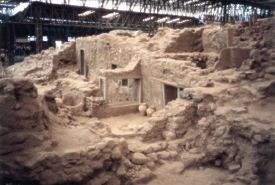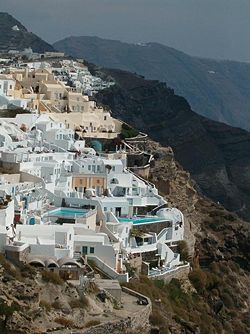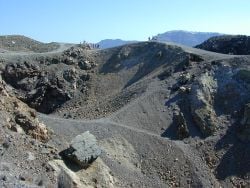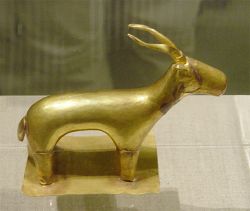Minoan eruption
The Minoan eruption was a major catastrophic volcanic eruption that occurred on the Greek island of Thera (known today as Santorini) in the mid-second millennium B.C.E. The eruption was one of the largest volcanic events on Earth in recorded history. It devastated the island of Thera, including the ancient Minoan settlement at Akrotiri as well as communities and agricultural areas on nearby islands and on the coast of Crete. The eruption may have contributed to the collapse of the Minoan culture. It has also sometimes been claimed to have caused climatic changes, and the eruption seems to have inspired certain Greek myths. It also possibly caused turmoil in Egypt and influenced the biblical Exodus stories. Additionally, it has been speculated that the Minoan eruption and the destruction of the city at Akrotiri provided the basis for, or otherwise inspired, Plato's story of Atlantis.
Eruption
Geological evidence shows the Thera volcano erupted numerous times over several hundred-thousand years before the Minoan eruption. In a repeating process, the volcano would violently erupt, then eventually collapse into a roughly circular seawater-filled caldera, with numerous small islands forming the circle. The caldera would slowly refill with magma, building a new volcano, which erupted and then collapsed in an ongoing cyclical process.[1] Another famous volcano known to repeat a similar process is Krakatoa in Indonesia.
Immediately prior to the Minoan eruption, the walls of the caldera formed a nearly continuous ring of islands with the only entrance lying between Thera and the tiny island of Aspronisi.[1] This cataclysmic eruption was centered on a small island just north of the existing island of Nea Kameni in the centre of the then-existing caldera. The northern part of the caldera was refilled by the volcanic ash and lava, then collapsed again.
On Santorini, there is a 60 m (200 ft) thick layer of white tephra that overlies the soil clearly delineating the ground level prior to the eruption. This layer has three distinct bands that indicate the different phases of the eruption.[2] Since no bodies have been found at the Akrotiri site, Floyd W. McCoy, Professor of Geology and Oceanography, University of Hawaiʻi, notes that the local population had advance warning of the impending eruption, leaving the island prior to its destruction. However, the thinness of the first ash layer, along with the lack of noticeable erosion of that layer by winter rains before the next layer was deposited, indicate that the volcano gave the local population only a few months warning.[3]
Recent research by a team of international scientists in 2006 revealed that the Santorini event was much larger than the original estimate of 39 km3 (9.4 cu mi) of Dense-Rock Equivalent (DRE), or total volume of material erupted from the volcano, that was published in 1991.[4] With an estimated DRE in excess of 60 km3 (14 cu mi),[5][4] the volume of ejecta was approximately 100 km3 (24 cu mi), placing the Volcanic Explosivity Index of the Thera eruption at 6 or 7. This was up to four times what was thrown into the stratosphere by Krakatoa in 1883, a well-recorded event. The Thera volcanic events and subsequent ashfall probably sterilized the island, as occurred on Krakatoa. Only the Mount Tambora volcanic eruption of 1815 released more material into the atmosphere during historic times.[6]
Physical consequences
Volcanology
This Plinian eruption resulted in an estimated 30 km (19 mi) to 35 km (22 mi) high plume which extended into the stratosphere. In addition, the magma underlying the volcano came into contact with the shallow marine embayment, resulting in a violent steam eruption.
The event also generated a 35 m (110 ft) to 150 m (490 ft) high tsunami that devastated the north coast of Crete, 110 km (68 mi) away. The tsunami had an impact on coastal towns such as Amnisos, where building walls were knocked out of alignment. On the island of Anafi, 27 km (17 mi) to the east, ash layers 3 m (9.8 ft) deep have been found, as well as pumice layers on slopes 250 m (820 ft) above sea level.
Elsewhere in the Mediterranean there are pumice deposits which could have been caused by the Thera eruption. Ash layers in cores drilled from the seabed and from lakes in Turkey, however, show that the heaviest ashfall was towards the east and northeast of Santorini. The ash found on Crete is now known to have been from a precursory phase of the eruption, some weeks or months before the main eruptive phases, and would have had little impact on the island.[7] Santorini ash deposits were at one time claimed to have been found in the Nile delta,[8] but this is now known to be a misidentification.[9][10]
Date
The Minoan eruption provides a fixed point for aligning the entire chronology of the second millennium B.C.E. in the Aegean, because evidence of the eruption is found throughout the region. Despite this evidence, the exact date of the eruption has been difficult to determine. Current estimates based on radiocarbon dating indicate that the eruption occurred between 1627 B.C.E. and 1600 B.C.E. However, this range of dates conflicts with the previous estimate, based on archaeological studies utilizing conventional Egyptian chronology, of about a century later.[11][12]
Archaeologists developed the Late Bronze Age chronologies of eastern Mediterranean cultures by analyzing the origin of artifacts (for example, items from Crete, mainland Greece, Cyprus or Canaan) found in each archaeological layer.[13] If the artifact's origin can be accurately dated, then it gives a reference date for the layer in which it is found. If the Thera eruption could be associated with a given layer of Cretan (or other) culture, chronologists could use the date of that layer to date the eruption itself. Since Thera's culture at the time of destruction was similar to the Late Minoan IA (LMIA) culture on Crete, LMIA is the baseline to establish chronology elsewhere. The eruption also aligns with Late Cycladic I (LCI) and Late Helladic I (LHI) cultures, but predates Peloponnesian LHI.[14] Archeological digs on Akrotiri have also yielded fragments of nine Syro-Palestinian Middle Bronze II (MBII) gypsum vessels.[13]
At one time, it was believed that data from Greenland ice cores could be useful in ascertaining the exact date of the eruption. A large eruption, identified in ice cores and dated to 1644 B.C.E. (+/- 20 years) was suspected to be Santorini. However, volcanic ash retrieved from an ice core demonstrated that this was not from Santorini, leading to the conclusion that the eruption may have occurred on another date.[7] The late Holocene eruption of the Mount Aniakchak, a volcano in Alaska, is proposed as the most likely source of the minute shards of volcanic glass in the Greenland ice core.[15]
Another method used to established the date of eruption is tree-ring dating. Tree-ring data has shown that a large event interfering with normal tree growth in the United States occurred during 1629-1628 B.C.E.[16] Evidence of a climatic event around 1628 B.C.E. has been found in studies of growth depression of European oaks in Ireland and in Sweden.[17]
In 2006, two research papers were published arguing that new radiocarbon analysis dated the eruption between 1627 B.C.E. and 1600 B.C.E. Samples of wood, bone, and seed collected from various locations in the Aegean, including Santorini, Crete, Rhodes and Turkey, were analyzed at three separate labs in Oxford, Vienna, Austria, and Heidelberg, Germany in order to minimize the chance of a radiocarbon dating error. Results of the analysis indicated a broad dating for the Thera event between 1660 to 1613 B.C.E.[18][19] Also that year the radiocarbon-indicated date of the eruption of Thera was narrowed to between 1627 and 1600 B.C.E., with a 95 percent probability of accuracy, after researchers analyzed material from an olive tree that was found buried beneath a lava flow from the volcano.[20] Because the tree grew on the island, the results may have been affected by volcanic outgassing, which would have skewed the accuracy of the radiometric studies.
Although radiocarbon indicates a 1600 B.C.E. eruption dating, archeologists believe that the date is contradicted by findings in Egyptian and Theran excavations. For example, some archeologists have found buried Egyptian and Cypriot pottery on Thera that is dated to a later period than the radiometric dates for the eruption. Since the Egyptian historical chronology has been established by numerous archeological studies, the exact date of the eruption remains controversial. If radiocarbon dating is accurate, there would be significant chronological realignment of several Eastern Mediterranean cultures.[21]
Climatic effects
Hydrogeologist Philip LaMoreaux asserted in 1995 that the eruption caused significant climatic changes in the eastern Mediterranean region, Aegean Sea and much of the Northern Hemisphere,[22] but this was forcefully rebutted by volcanologist David Pyle a year later.[23]
Around the time of the radiocarbon-indicated date of the eruption, there is evidence for a significant climatic event in the Northern Hemisphere. The evidence includes failure of crops in China (see below), as well as evidence from tree rings, cited above: bristlecone pines of California; bog oaks of Ireland, England, and Germany; and other trees in Sweden. The tree rings precisely date the event to 1628 B.C.E.[16][17]
Historical impact
Minoan civilization
The Minoan eruption devastated the nearby Minoan settlement at Akrotiri on Santorini, which was entombed in a layer of pumice.[24] It is believed that the eruption also severely affected the Minoan population on Crete, although the extent of the impact is debated. Early theories proposed that ashfall from Thera on the eastern half of Crete choked off plant life, causing starvation of the local population. [25] However, after more thorough field examinations, this theory has lost credibility, as it has been determined that no more than 5 mm (0.20 in) of ash fell anywhere on Crete.[26] Other theories have been proposed based on archaeological evidence found on Crete indicating that a tsunami, likely associated with the eruption, impacted the coastal areas of Crete and may have severely devastated the Minoan coastal settlements.[27][28] A more recent theory is that much of the damage done to Minoan sites resulted from a large earthquake that preceded the Thera Eruption.[29]
Significant Minoan remains have been found above the Late Minoan I era Thera ash layer, implying that the Thera eruption did not cause the immediate downfall of the Minoans. As the Minoans were a sea power and depended on their naval and merchant ships for their livelihood, the Thera eruption likely caused significant economic hardship to the Minoans—and probable loss of empire in the long run.
Whether these effects were enough to trigger the downfall of the Minoan civilization is under intense debate. The Mycenaean conquest of the Minoans occurred in Late Minoan II period, not many years after the eruption, and many archaeologists speculate that the eruption induced a crisis in Minoan civilization, which allowed the Mycenaeans to conquer them easily.[28]
Chinese records
Some scientists correlate a volcanic winter from the Minoan eruption with Chinese records documenting the collapse of the Xia dynasty in China. According to the Bamboo Annals, the collapse of the dynasty and the rise of the Shang dynasty, approximately dated to 1618 B.C.E., were accompanied by "'yellow fog, a dim sun, then three suns, frost in July, famine, and the withering of all five cereals."[30]
Impact on Egyptian history
There are no surviving Egyptian records of the eruption, and the absence of such records is sometimes attributed to the general disorder in Egypt around the Second Intermediate Period. However, there are connections between the Thera eruption and the calamities of the Admonitions of Ipuwer, a text from Lower Egypt during the Middle Kingdom or Second Intermediate Period.[31]
Heavy rainstorms which devastated much of Egypt, and were described on the Tempest Stele of Ahmose I, have been attributed to short term climatic changes caused by the Theran eruption.[32][30] This theory is not supported by current archaeological evidence which show no pumice layers at Avaris or elsewhere in Lower Egypt during the reigns of Ahmose I and Thutmosis III.
While it has been argued that the damage from this storm may have been caused by an earthquake following the Thera Eruption, it has also been suggested that it was caused during a war with the Hyksos, and the storm reference is merely a metaphor for chaos, upon which the Pharaoh was attempting to impose order.[33]
There is a consensus that Egypt, being far away from areas of significant seismic activity, would not be significantly affected by an earthquake in the Aegean. Furthermore, other documents, such as Hatshepsut's Speos Artemidos, depict similar storms, but are clearly speaking figuratively, not literally. Research indicates that this particular stele is just another reference to the Pharaoh overcoming the powers of chaos and darkness.[33]
Greek traditions
The eruption of Thera and volcanic fallout may well have inspired the myths of the Titanomachy in Hesiod's Theogony.[34] The background of the Titanomachy may derive from the Kumarbi cycle, a Bronze Age Hurrian epic from the Lake Van region.
However, the Titanomachy itself could have picked up elements of western Anatolian folk memory as the tale spread westward. Hesiod's lines have been compared with volcanic activity, citing Zeus' thunderbolts as volcanic lightning, the boiling earth and sea as a breach of the magma chamber, immense flame and heat as evidence of phreatic explosions, among many other descriptions.[35]
Atlantis
There is some archaeological, seismological, and vulcanological evidence that the myth of Atlantis, described by Plato, is based upon the Santorini eruption.[36][24][27]
Biblical traditions
Researchers have hypothesized that some of the ten plagues resulted from the eruption of Thera; however, the presumed dates of the events of Exodus, approximately 1450 B.C.E., are almost 150 years after the radiometric date of the eruption.[37]
According to the Bible, Egypt was beset by such misfortunes as the transforming of their water supply to blood, the infestations of frogs, gnats, and flies, darkness, and violent hail. These effects are compatible with the catastrophic eruption of a volcano in different ways. While the "blood" in the water could have been red tide which is poisonous to human beings, the frogs may have been displaced by the eruption, and their eventual death would have given rise to large numbers of scavenging insects. The darkness could have been the resulting volcanic winter, and the hail the large chunks of ejecta that spewed from the volcano. The tsunami that resulted from the Thera eruption could have been the basis for the parting of the sea, when the sea receded from the shore immediately prior to the arrival of the tsunami. Shallow areas of the sea would have allowed the Israelites, under Moses, safe passage across the Red Sea, while the ensuing tsunami devastated the Egyptian army. Exodus mentions that the Israelites were guided by a "pillar of cloud" during the day and a "pillar of fire" at night, and Colin Humphreys, Professor of Material Science at Cambridge University, has argued that a volcanic eruption perfectly fits "the description “pillar of cloud by day and pillar of fire by night.”[38][30]
Notes
- ↑ 1.0 1.1 W.L. Friedrich, Fire in the Sea, the Santorini Volcano: Natural History and the Legend of Atlantis (Cambridge University Press, 1999, ISBN 0521652901).
- ↑ D.A. Davidson, "Aegean Soils During the Second Millennium B.C.E. with Reference to Thera" in Thera and the Aegean World I. Papers presented at the Second International Scientific Congress, Santorini, Greece, August 1978, 725-739. The Thera Foundation, 1979.
- ↑ G. Heiken and F. McCoy, "Precursory Activity to the Minoan Eruption, Thera, Greece" in Thera and the Aegean World III, Vol 2 The Thera Foundation, 1990, 79-88.
- ↑ 4.0 4.1 The size of the Minoan eruption Volcano Discovery. Retrieved March 1, 2019.
- ↑ H. Sigurdsson, S. Carey, M. Alexandri, G. Vougioukalakis, K. Croff, C. Roman, D. Sakellariou, C. Anagnostou, G. Rousakis, C. Ioakim, A. Gogou, D. Ballas, T. Misaridis, and P. Nomikou, "Marine Investigations of Greece's Santorini Volcanic Field" Eos 87(34) (2006): 337–348.
- ↑ Clive Oppenheimer, "Climatic, environmental and human consequences of the largest known historic eruption: Tambora volcano (Indonesia) 1815" Progress in Physical Geography 27(2) (2003):230–259.
- ↑ 7.0 7.1 Douglas J. Keenan, Volcanic ash retrieved from the GRIP ice core is not from Thera Geochemistry Geophysics Geosystems 4(11) (2003):1097. Retrieved March 1, 2019.
- ↑ D.J. Stanley and H. Sheng, "Volcanic shards from Santorini (Upper Minoan ash) in the Nile Delta, Egypt" Nature 320 (1986):733-735.
- ↑ F. Guichard, et al., "Tephra from the Minoan eruption of Santorini in sediments of the Black Sea" Nature 363(6430) (1993): 610-612.
- ↑ I. Liritzis, C. Michael, and R.B. Galloway, "Aegean volcanic eruption during the second millennium B.C.E. revealed by thermoluminescence dating," Geoarchaeology, 11 (1996): 361-371.
- ↑ Alex Kwan, Cornell study of ancient volcano, seeds and tree rings suggests rewriting Late Bronze Age Mediterranean history Cornell Chronicle, April 28, 2006. Retrieved March 1, 2019.
- ↑ P.M. Warren, Timelines: Studies in Honour of Manfred Bietak (Orientalia Lovaniensia Analecta 149) (Louvain-la-Neuve, Belgium: Peeters, 2006, ISBN 904291730X): 305–321.
- ↑ 13.0 13.1 P.M. Warren, "Summary of Evidence for the Absolute Chronology of the Early Part of the Aegean Late Bronze Age Derived from Historical Egyptian Sources" in Thera and the Aegean World III, D.A. Hardy, (ed.) (The Thera Foundation, 1989), 24–26.
- ↑ Y.G. Lolos, On the Late Helladic I of Akrotiri, Thera (The Thera Foundation, 1989).
- ↑ N.J.G. Pearce, J. A. Westgate, S. J. Preece, W. J. Eastwood, and W. T. Perkins "Identification of Aniakchak (Alaska) tephra in Greenland ice core challenges the 1645 B.C.E. date for Minoan eruption of Santorini" Geochem. Geophys. Geosyst. 5 (2004).
- ↑ 16.0 16.1 M.G.L. Baillie, Irish Tree Rings and an Event in 1628 B.C.E. (The Thera Foundation, 1989.)
- ↑ 17.0 17.1 H. Grudd, K.R. Briffa, B.E. Gunnarson, and H.W. Linderholm, "Swedish tree rings provide new evidence in support of a major, widespread environmental disruption in 1628 B.C.E." Geophysical Research Letters 27(18) (2000):2957–2960.
- ↑ Sturt W. Manning, C.B. Ramsey, W. Kutschera, T. Higham, B. Kromer, P. Steier, and E.M. Wild, "Chronology for the Aegean Late Bronze Age 1700-1400 B.C.E. Science 312(5773) (2006):565–569. Retrieved March 1, 2019.
- ↑ S.W. Manning, Clarifying the "high" v. "low" Aegean/Cypriot chronology for the mid second millennium B.C.E.: assessing the evidence, interpretive frameworks, and current state of the debate in M. Bietak and E. Czerny (eds.), The Synchronisation of Civilisations in the Eastern Mediterranean in the Second Millennium B.C.E. III. Proceedings of the SCIEM 2000 - 2nd EuroConference, Vienna 28th of May - 1st of June 2003, 101-137. Retrieved March 1, 2019.
- ↑ Walter L. Friedrich, B. Kromer, M. Friedrich, J, Heinemeier, T. Pfeiffer, and S. Talamo, "Santorini Eruption Radiocarbon Dated to 1627-1600 B.C.E." Science 312(5773) (2006):548. Retrieved March 1, 2019.
- ↑ M. Balter, "New Carbon Dates Support Revised History of Ancient Mediterranean" Science 312(5773) (2006):508–509.
- ↑ P.E. LaMoreaux, "Worldwide environmental impacts from the eruption of Thera" Environmental Geology 26(3) (1995):172–181.
- ↑ D.M. Pyle, "The global impact of the Minoan eruption of Santorini, Greece" Environmental Geology 30(1/2) (1997):59–61.
- ↑ 24.0 24.1 Dan Vergaro, Ye gods! Ancient volcano could have blasted Atlantis myth USA Today, August 27, 2006. Retrieved March 1, 2019.
- ↑ S. Marinatos, "The Volcanic Destruction of Minoan Crete" Antiquity 13 (1939): 425–439.
- ↑ G. Callender, The Minoans and the Mycenaeans: Aegean Society in the Bronze Age (Oxford University Press, 1999, ISBN 0195510283).
- ↑ 27.0 27.1 Harvey Lilley, The wave that destroyed Atlantis BBC Timewatch, April 20, 2007. Retrieved March 1, 2019.
- ↑ 28.0 28.1 J. Antonopoulos, "The great Minoan eruption of Thera volcano and the ensuing tsunami in the Greek Archipelago" Natural Hazards 5 (1992):153–168.
- ↑ Owen Jarus, Knossos: Palace of the Minoans LiveScience, November 6, 2017. Retrieved March 1, 2019.
- ↑ 30.0 30.1 30.2 K.P. Foster, R.K. Ritner, and B.R. Foster, Texts, Storms, and the Thera Eruption Journal of Near Eastern Studies 55(1) (1996):1–14. Retrieved March 1, 2019.
- ↑ Angelos Galanopoulos, Atlantis: The Truth Behind the Legend (Bobbs-Merrill Co., 1969, ISBN 978-0672506109).
- ↑ Hans Goedicke, Studies about Kamose and Ahmose (David Brown Book Company, 1995, ISBN 0961380586).
- ↑ 33.0 33.1 H.W. Wiener, and J.P. Allen, "Separate Lives: The Ahmose Tempest Stela and the Theran Eruption" Journal of Near Eastern Studies 57 (1998):1–28.
- ↑ Greene, MT (2000). Natural Knowledge in Preclassical Antiquity. Johns Hopkins University Press. ISBN 9780801863714.
- ↑ John Victor Luce, The end of Atlantis: New light on an old legend (New Aspects of Antiquity) (Thames & Hudson, 1969, ISBN 978-0500390054).
- ↑ Santorini Eruption (~1630 B.C.E.) and the legend of Atlantis How Volcanoes Work. Retrieved March 1, 2019.
- ↑ John G. Bennett, |Geo-Physics and Human History: New Light on Plato's Atlantis and the Exodus Systematics 1(2) (1963). Retrieved March 1, 2019.
- ↑ C. Humphreys, "Science and the Miracles of Exodus" Europhysics News 36 (2005): 93-96.
ReferencesISBN links support NWE through referral fees
- Bietak, Manfred. "Review—'A Test of Time' by S.W. Manning (1999)" Bibliotheca Orientalis 61 (2004): 99–222.
- Callender, G. The Minoans and the Mycenaeans: Aegean Society in the Bronze Age. Oxford University Press, 1999. ISBN 0195510283
- Forsyth, P.Y. Thera in the Bronze Age. Peter Lang Publishing, 1997. ISBN 0820448893.
- Friedrich, W.L. Fire in the Sea, the Santorini Volcano: Natural History and the Legend of Atlantis. Cambridge University Press, 1999. ISBN 0521652901
- Galanopoulos, Angelos. Atlantis: The Truth Behind the Legend. Bobbs-Merrill Co., 1969. ISBN 978-0672506109
- Goedicke, Hans. Studies about Kamose and Ahmose. David Brown Book Company, 1995. ISBN 0961380586
- Luce, John Victor.The end of Atlantis: New light on an old legend (New Aspects of Antiquity). Thames & Hudson, 1969. ISBN 978-0500390054
- Warren, P.M. in E. Czerny, I. Hein, H. Hunger, D. Melman, A. Schwab, "Timelines: Studies in Honour of Manfred Bietak" (Orientalia Lovaniensia Analecta 149). Louvain-la-Neuve, Belgium: Peeters, 2006. ISBN 904291730X
External links
All links retrieved November 9, 2022.
Credits
New World Encyclopedia writers and editors rewrote and completed the Wikipedia article in accordance with New World Encyclopedia standards. This article abides by terms of the Creative Commons CC-by-sa 3.0 License (CC-by-sa), which may be used and disseminated with proper attribution. Credit is due under the terms of this license that can reference both the New World Encyclopedia contributors and the selfless volunteer contributors of the Wikimedia Foundation. To cite this article click here for a list of acceptable citing formats.The history of earlier contributions by wikipedians is accessible to researchers here:
The history of this article since it was imported to New World Encyclopedia:
Note: Some restrictions may apply to use of individual images which are separately licensed.



